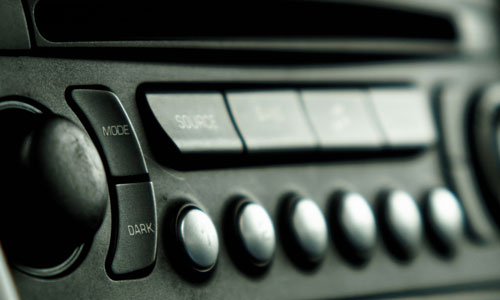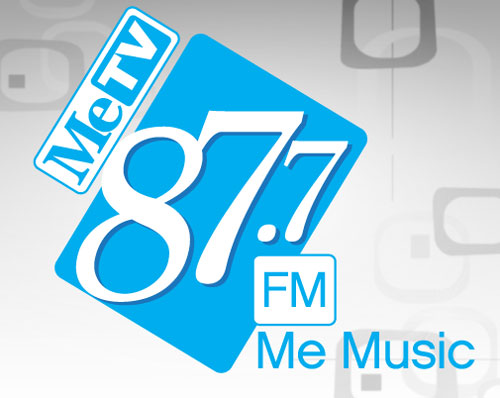Waaaaay Left of the Dial
Listening to 87.7 FM? That's not a radio station, but an old analog TV station—channel 6, to be exact. It's a total fluke, but Chicago's all over it.
87.76 MHz
The place on the FM radio dial taken up by the VHF station Channel 6, which takes up spectrum between 82.0 through 88.0 MHz. The 87.7 tuning technically falls below the reach of some radios, but can be accessed by many cars, especially older models. Due to the fact that VHF uses a similar audio standard to FM, it can be picked up on the radio. (In case you're wondering, the top end of the FM spectrum is taken up by civilian aeronautical communications.)

How the digital TV switchover made room for "FrankenFMs"
The digital television turnover in 2009 was meant to kill off analog television and replace it with a digital equivalent that took up less spectrum room.
This was done for a number of reasons, including the fact that it would open up that spectrum for other uses. Mobile phone companies, for one, have been licking their chops, waiting for the Federal Communications Commission to auction off this unused spectrum for new uses.
Broadcast stations, for the most part, are on board, but they're setting an incredibly high price for that spectrum: The FCC is paying $86.4 billion for spectrum that it plans to auction off, which, as The Wall Street Journal helpfully notes, is a price tag higher than the market cap of T-Mobile and Sprint combined. (It should be noted that some local stations are being offered deals by the FCC to go off the broadcast airwaves completely, in favor of cable and satellite television-only offerings.)
But there are a few holdouts on the analog front, and many of them are flittering around on channel 6. Here's why: Despite the fact that full-powered analog stations were forced to shut off in 2009, low-powered television (LPTV) stations were allowed to stay on the air in analog form. Some stations with access to the channel 6 VHF signal took advantage of this exception to start broadcasting on the radio—moving beyond simply a nice side effect and into a way to slightly expand the FM dial a little bit.
Technically, these stations, called FrankenFMs in the industry for their cobbled-together nature, have to broadcast with a video signal of some kind, but it's basically just a way to get around federal regulations. This phenomenon has proven helpful for certain types of audiences underserved by traditional radio, and has led to a number of small stations, such as Cleveland's Latino-focused "La Mega," call signs WLFM-LP, finding a new home on the dial.
The situation became troublesome enough that in 2014, the FCC, when delaying the low-power television shutoff, actually suggested making the pseudo-FM stations into a permanent thing, and called for comments around that time.
In a response to the FCC filed in February of last year, La Mega noted that it was playing a valuable role in its community—and that similar stations do the same.
"Licensees already providing the service are adding to the overall competitive environment in their communities, and are making optimal use of the spectrum to the overall betterment of Section 307(b) of the Communications Act," the station wrote in its letter.
Here's a weird thing to consider: Much of the radio station's letter focused on criticizing NPR. Why's that? Well, NPR friggin' hates FrankenFM stations.
"The promise of digital television long touted by the Commission should amount to more than an LPTV station masquerading as an analog FM radio station."
— Comments made by National Public Radio in a January 2015 FCC filing that specifically oppose allowing the use of low-power television stations for the purpose of FM radio. This is not a new drumbeat for NPR, which has a reason to be upset. Basically, these stations work around an existing dynamic—specifically, that radio stations to the left of the dial are set aside for publicly operated services like NPR or those college radio stations Paul Westerberg loves. Now, because of sheer chance, TV networks with an FCC license to broadcast on channel 6 can now run their own radio stations. NPR, in extensive research into the issue, says that channel 6 has a tendency to negatively affect FM radio signals. La Mega disputes this, saying in its FCC comments: "As the Commission has stated, loss of service once a station commences operations is prima facie inconsistent with the public interest."

The Chicago oldies station tempting tradition with its odd placement
For decades, the TV on the radio phenomenon was simply an unintended consequence, a sheer happenstance of allocation.
But in 2008, with analog television preparing for its sunset, the format suddenly got interesting. That's largely thanks to the TV broadcaster Venture Technologies, which started experimenting with the radio dial location in Chicago in 2009 just as the final analog TV broadcasts went off the air.
Venture first tried its hand at alternative country, apparently hoping to win over some of the city's Wilco fans. But thanks to some quick thinking, the company soon found an opening, after a smooth jazz station went off the air. Within hours, Venture switched its own format to smooth jazz, quickly winning over listeners who prefer things to be smooth, rather than frustrating.
But ultimately, smooth jazz didn't stick, and Venture quit running the station itself, blaming the unusual situation around its FM signal for letting it go. Since then, the station has been licensed out to different companies, who have each played with a wide variety of experimental formats, including alternative rock, sports talk radio, and even rebroadcasting WGN's AM signal on the FM dial.
But it's the station's latest format that's arguably its most interesting. Taking some clear inspiration from the recent trend of digital subchannels that play incredibly old TV shows, Weigel Broadcasting, which owns MeTV, launched a licensing agreement to run the station last year and has since been running it as MeTV-FM, an oldies station that isn't afraid to play some stuff that hasn't seen the light of day in a few decades.
The station plays stuff like James Taylor, Air Supply, and Paul Simon without flinching, sometimes diving into songs that don't get a ton of regular play on normal oldies stations. The strategy is working; it's kicking ass in the ratings despite the fact that some cars can't even play it. In March, the station netted the highest-ever rating received by a FrankenFM.
MeTV-FM has gotten some great reviews from radio fans, one of whom, internet radio programmer Bruce David Janu, recorded a video of himself listening to the station on his drive into work.
"Perhaps MeTV-FM is the first station in town to recognize that the competition is not other terrestrial radio stations, but internet radio—mainly Pandora and Spotify," Janu wrote on his Vinyl Voyager Radio website. "And they created their station to emulate the variety that internet stations offer. And it is working."
At Radio Survivor, which has been closely watching the FrankenFM phenomenon, the website's Paul Riismandel argued last year that the success that the station is seeing could lead Weigel to make a bigger play on a part of the radio dial that isn't showing up due to a technological fluke.
"Beyond it being a back-door FM station, MeTV FM is an interesting experiment, because by all accounts it’s a fresh take on an old format," he wrote. "It will be all the more fascinating if it can make the jump to a legitimate FM station."
When I was a kid, I remember there being something magic about the quirk that TV on the radio gave us. It was the trick that, when separated from Saturday morning cartoons, allowed Muppet Babies to keep playing. Well, at least in audio form.
That it was essentially a quirk of the airwaves, I didn't know that at the time, but it makes a lot of sense. To see it come back in this specific way is kind of awesome—it shows that given the right tools, someone out there is going to bend it to their will.
For now, these FrankenFM stations stay on the air, having earned a reprieve last April. But who knows how long that'll last? There's a lot of money to be made.
This whole conflict highlights another lingering tension: that between broadcasters and mobile providers, who have been eating their lunch of late. Last year, the National Association of Broadcasters raised an issue with phone-makers who have basically refused to turn on the FM radio chips built into phones, despite the fact that they're baked in.
Those same phone-makers, through the wireless signals that their devices rely on, are causing severe changes in the television market. But the mere existence of MeTV FM highlights a big problem with radio as a whole: There aren't enough stations to go around, and the ones on the dial are stretched too thin.
Last year in Radio magazine, a pseudonymous blogger named The Wandering Engineer recommended that the FCC sell the spectrum around Channel 6 to AM radio broadcasters, who are struggling to keep up in the modern age.
"Everyone has receivers that almost work on Channel 6. It’s not much of a jump to extend the FM band down, and that makes a lot more sense than the reasonably recent 'extend the AM band up,' movement did. Adding more services to an exhausted medium works about as well as bloodletting did," the blogger argued.
Odds are that this is idea is a bit of a pipe dream, but we are reaching the limits of a technology that is still useful, that everyone has, but that needs a bit more variety to stay in the game. Our phones are awesome, but as a passive broadcast medium, radio certainly deserves the opportunity to broaden out one of these days—an extra station or two would be nice, and would help get around the homogeneity problem that limits what we hear on a daily basis.
Maybe our phones can live with a little less spectrum.
:format(jpeg)/2018/01/p7lpwbqfaunjbvocn1zo--1-.gif)
/2018/01/p7lpwbqfaunjbvocn1zo--1-.gif)

/uploads/ernie_crop.jpg)